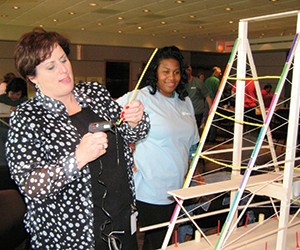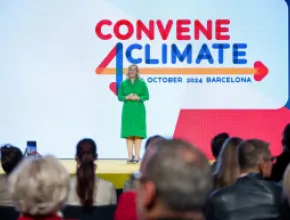Following years of anticipation, there will soon be a clearer answer to the still lingering question: What is a green meeting?
Incurring nearly as much debate as the nation’s health care reform, the APEX/ASTM Environmentally Sustainable Meetings Standards are in the final stages of review and slated for release this year.
The Convention Industry Council’s (CIC) Accepted Practices Exchange (APEX) Panel on Green Meeting and Event Practices last year released its final draft standards for green meetings and events for review and comment by the meetings industry. Developed in collaboration by the U.S. Environmental Protection Agency (EPA), the Green Meeting Industry Council (GMIC) and APEX, the standards were also submitted to ASTM International to become accredited standards upon approval.
Three-Fold Approach
The APEX standards take a three-fold approach to sustainability, considering the economic, environmental and social aspects of meetings and events. The goal is to create a voluntary, industry-wide set of standards that would act as a veritable roadmap for planners and suppliers in organizing sustainable meetings.
"After two years of planning, discussions, workgroup, region meetings and review by more than 200 industry volunteers and professional standards writers, the APEX standard is scheduled for release [this year]," says Michael Luehrs, sustainability services manager for the MCI Headquarters Office in Stockholm. Luehrs served as a committee member on the venues group and the accommodations group during the development of the standards.
"One could say they are in effect nine standards, covering nine areas unique to the meetings industry: accommodations, audiovisual and production, communications and marketing, destinations, exhibits, food and beverage, meeting venue, on-site offices and transportation," he explains. "Because each of the nine areas was subject to its own committee of professionals and had different degrees of complexity, each section has taken a different amount of time to complete."
Amy Spatrisano, principal of Portland, Ore.-based MeetGreen and co-founder of GMIC, explains how the concept for an industry standard was born. An EPA bill put before the House of Representatives in 2007 included components about green meetings, which were eventually cut from the bill before it passed.
"That was good it didn’t pass, because no industry person participated in the writing of the bill," she recalls. "I heard about it and contacted the EPA contact we have through GMIC to see how we could collaborate on this. I provided them with names of industry people who could be involved... APEX found out about the work we were doing and asked whether they could ‘crash the party’."
EPA wanted to be sure the standards were developed by an ANSI (American National Standards Institute) certified organization and recommended ASTM, one of the largest standards development and delivery systems in the world. Spatrisano agreed to chair the green meetings and events practice panel for APEX and collaborate with ASTM to develop the standards.
"This was supposed to have been passed last year," Spatrisano says. "I was very naive when I took on this role. What seemed simple really wasn’t. We’re really setting groundwork for our industry."
Part of the delay is the ASTM process itself.
"Every time we ballot the standards the ASTM community has 30 days to comment and we have to respond to every negative comment," says Sue Tinnish, ASTM liaison and chair of the ASTM committee on sustainability.
"There have been hundreds of pages of responses," Spatrisano says. "The enormity of this project, anyone of us in it doesn’t quite get it yet."
Six sectors are in adjudication, while the remaining three—meeting venue, food and beverage and accommodations—are just entering the adjudication process, according to Spatrisano.
"The three most problematic are the biggest," Spatrisano says. "Those are the things people think of first. The three largest bodies of work are the most complex."
Sustainability Levels
According to Tinnish, the standards introduce not only another level of complexity, but also another level to differentiate a meeting and to differentiate suppliers.
The standards are rated from level one to level four, four being the highest, as far as levels of sustainability.
"There were challenging conversations around what’s basic enough," Spatrisano explains. "We didn’t want the bar too low or too high. We all recognize that the standards that will be launched will not be perfect; we expect they will go through a revision process."
Each sector contains separate standards for planners and suppliers, allowing the responsibility for implementation to be shared. Some standards have also been established for CVBs and destinations.
According to Spatrisano, the standards had to be planner and supplier compliable.
"These require both parties to perform," she says. "The supplier can do a fabulous job, but if the supplier recycles and the planner brings in Styrofoam or multiple plastics that the venue cannot recycle, then the facility can’t reach the numbers it needs to keep at a level they want to be on. That’s the planner accountability. Two parties have to work together in a different way than they have had to do before."
The standards are designed to be used as a checklist, to reveal what level a planner or supplier is at and what is entailed to get to the next level. For example, with regard to food and beverage, the APEX standards will include an option that the planner request all seafood be sustainable or that carry-out or concession packaging must be compostable and biodegradable.
"People want to know what they need to do to be green," Spatrisano says. "With the standards they know where to start from… a step in reducing their environmental footprint and improving social responsibility."
The APEX standards are not the first to be released. The British Standard BS 8901 was released a couple of years ago and was developed with a purpose of helping the events industry operate in a more sustainable manner.
"It is important to note that the two standards are different in their approach to defining a sustainable event standard," Spatrisano says. "The BS 8901 standard is a management system written to inform the process of organizing an event, while the APEX standard provides definitions of specific operational actions with key performance measures. The standards will work well independently or in collaboration as frameworks for sustainable events."
Plans call for the GMIC to create a certification program for planners and suppliers with the help of CIC.
"Certification will be similar to CMP certification in a very general sense," Spatrisano says. "But we have to get the standards out there first. The certification is a good year and half away."







